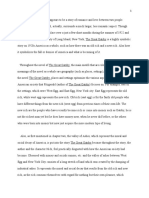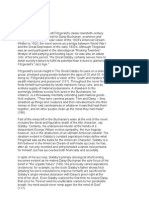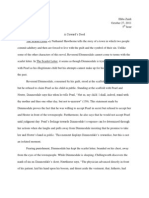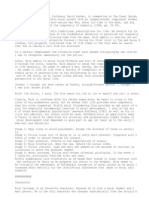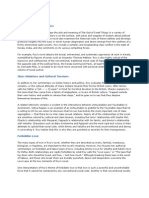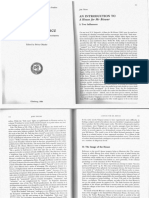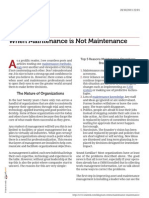0 ratings0% found this document useful (0 votes)
324 viewsThe Corruption of The American Dream in Great Gatsby
The Corruption of The American Dream in Great Gatsby
Uploaded by
Showket IbraheemThe aim of this research is to highlight the symbolic meaning of east and west in Fitzgerald’s novel The Great Gatsby. The West Egg is the home of Gatsby and those who are like him, who gain huge wealth but they lack the traditions associated with inherited property and therefore are uncouth, and because they do not have any traditions of their own, they try to copy those of others.
Copyright:
© All Rights Reserved
Available Formats
Download as DOCX, PDF, TXT or read online from Scribd
The Corruption of The American Dream in Great Gatsby
The Corruption of The American Dream in Great Gatsby
Uploaded by
Showket Ibraheem0 ratings0% found this document useful (0 votes)
324 views4 pagesThe aim of this research is to highlight the symbolic meaning of east and west in Fitzgerald’s novel The Great Gatsby. The West Egg is the home of Gatsby and those who are like him, who gain huge wealth but they lack the traditions associated with inherited property and therefore are uncouth, and because they do not have any traditions of their own, they try to copy those of others.
Original Title
The Corruption of the American Dream in Great Gatsby
Copyright
© © All Rights Reserved
Available Formats
DOCX, PDF, TXT or read online from Scribd
Share this document
Did you find this document useful?
Is this content inappropriate?
The aim of this research is to highlight the symbolic meaning of east and west in Fitzgerald’s novel The Great Gatsby. The West Egg is the home of Gatsby and those who are like him, who gain huge wealth but they lack the traditions associated with inherited property and therefore are uncouth, and because they do not have any traditions of their own, they try to copy those of others.
Copyright:
© All Rights Reserved
Available Formats
Download as DOCX, PDF, TXT or read online from Scribd
Download as docx, pdf, or txt
0 ratings0% found this document useful (0 votes)
324 views4 pagesThe Corruption of The American Dream in Great Gatsby
The Corruption of The American Dream in Great Gatsby
Uploaded by
Showket IbraheemThe aim of this research is to highlight the symbolic meaning of east and west in Fitzgerald’s novel The Great Gatsby. The West Egg is the home of Gatsby and those who are like him, who gain huge wealth but they lack the traditions associated with inherited property and therefore are uncouth, and because they do not have any traditions of their own, they try to copy those of others.
Copyright:
© All Rights Reserved
Available Formats
Download as DOCX, PDF, TXT or read online from Scribd
Download as docx, pdf, or txt
You are on page 1of 4
The Corruption of the American dream in great Gatsby
According to Veronica Makowskys article in Approaches to teaching Fitzgeralds
The Great Gatsby, F. Scott Fitzgerald initially intended for his novel to have the
title Among the Ash-heaps and Millionaires which would suggest that the author
saw the issue of class as an important theme in the novel. Ash-heaps refers to the
area of ashes where for instance the Wilsons live as well as other member of the
working class. This area is a great contrast to that of the fashionable East Egg
where the Buchanans and other members of the upper class live (Makowsky 75).
Throughout the story Gatsby is in pursuit of a dream. There are many claims for
what that dream represents among scholars as well as readers, the most common
ones being the love of Daisy Buchanan and the American dream. The concept of
the American dream is closely related to the notion of class and although the
American dream will not be the main focus of this thesis it will be dealt with to
some extent. The American dream is a much wider concept than class and was,
according to Therse Johanssons thesis: The Broken Dream, originally an
expression describing the wish for a better life among the people who migrated to
America. Later on it would include aspirations towards a better life for those
already living in America as well (Therse 2).
On the surface The Great Gatsby might seem to be a tragic love story between the
golden girl and a poor young soldier going to war. The main theme of the novel
however operates on a much larger scale and it would be a mistake not to
recognize it. The novel offers a story of a whole generation. It is a story of a whole
era, the Jazz era. Throughout American history the 1920s have always been
referenced to as the golden age. It was a time of prosperity and material excess.
Everybody could achieve the American dream if they tried hard enough. It was
also a time of incredible hope. The American dream suddenly became something
that everybody strived for. Fitzgerald experienced his American dream also when
he became an instant celebrity after the publication of his first novel. To some the
1920s seemed almost like a dream. It was a careless time of living like there is no
tomorrow:
They were careless people, Tom and Daisy- they smashed up things
and creatures and then retreated back into their money or their vast
carelessness or whatever it was that kept them together, and let other
people clean up the mess they had made. (GG, 2005, p.181)
However the dream has been corrupted. Fitzgerald portrays the 1920s as a time of
decayed social and moral values, time of greed and cynicism. People were
interested only in pursuit of the material possessions and sexual pleasure. And it
was all accompanied by the sound of the wild jazz music. After the war people
returned haunted by the experience. They became the Lost generation.
Suddenly there was nothing more important than the gayety and enjoyment. This
eventually led to the stock market crash in 1929.
With the two luxurious neighborhoods West Egg and East Egg Fitzgerald
represents the divided society. The two Eggs, even though they might look alike,
are different in behavior and values, which is demonstrated by the behavior of a
few East Egg residents at a West Egg party: Instead of rambling this party had
preserved a dignified homogeneity, and assumed to itself the function of
representing the staid nobility of the countryside East Egg condescending to
West Egg, and carefully on guard against its spectroscopic gayety (Fitzgerald 47).
Fitzgerald makes East Egg the symbol of the old money America that despises
the new money America which is symbolized by West Egg. ( Flth 16)
With focus on their socioeconomic backgrounds, Fitzgerald makes clear examples
of the typical residents of both East and West Egg. Tom and Daisy Buchanan are
the typical residents of East Egg as they have always been wealthy and possess the
freedom that comes with it. They are described as people that without any further
purpose drift: here and there unrestfully wherever people played polo and were
rich together (Fitzgerald 13). To them, there is nothing more to life than existing
in this state of mind (Barbour 70). Gatsby, on the other hand, is the typical resident
of West Egg. With his lack of family wealth and his self-earned fortune he
represents the opposite from Tom and Daisy Buchanan. While the Buchanans seem
to live without goals or ambition, Fitzgerald shows Gatsbys ambitions with the
schedule over his daily activities (162).
As Fitzgerald points out through Nicks observations, the American dream used to
be symbolized with discovery, individualism and the pursuit of happiness.
However the relaxed and frivolous atmosphere of the 1920s has corrupted the
dream. It has become synonymous with materialistic values, greed and immoral
behavior. Gatsbys dream of loving Daisy is at first met with obstacles because
they come from different social backgrounds and he cant offer her what she is
used to. Later when he finally achieves material success and stability, Daisy is no
longer available. That is the sad irony of Gatsby's dream:
Gatsby believed in the green light, the orgastic future that year by
year recedes before us. It eluded us then, but thats no matter to-
morrow we will run faster, stretch out our arms farther. . . . And
one fine morning So we beat on, boats against the current,
borne back ceaselessly into the past. (GG,2005, p. 183)
The premise of the American dream is that if you work hard enough to get
something you will succeed. What he and other characters fail to realize is that the
dream is just an illusion. Gatsby in a way embodies the American dream. He
comes from nothing and becomes somebody. He has a desire and motivation to get
his girl back but like many times before in the history he falls short of his dream.
Fitzgerald is very clever with placing his symbols and motifs. He interconnects
them and so everything in the novel seems to have a deeper meaning. The green
light is not just a light at the end of the dock. It is a symbol of the American dream.
But while Gatsby symbolizes it with Daisy because she is his ultimate dream, Nick
is able to connect it to American past.( ( Pchov pp.33,34))
7- Sebastian Flth. Social Class and Status in Fitzgeralds The Great Gatsby. Sweden: Halmstad
University,2013.
8- Barbour, Brian M. Two American Dreams in Conflict. Johnson 72-67.
9- Johansson, Therse. The Broken Dream: The Failure of the American Dream in The Grapes of
Wrath from a Caste and Class perspective. Linnaeus University, 2010.
10-Makowsky, Veronica. Among the Ash-heaps and Millionaires. Approaches to teaching
Fitzgeralds The Great Gatsby. Ed. Jackson R. Bryer & Nancy P. VanArsdale. New York: Modern
Language Association of America, 2009. 75-83.
You might also like
- The Great Gatsby Research PaperDocument5 pagesThe Great Gatsby Research PaperHayden Casey0% (1)
- Novena To San Pedro CalungsodDocument17 pagesNovena To San Pedro CalungsodJohnNo ratings yet
- The Great Gatsby Revision - Quotes, Critics + ThemesDocument8 pagesThe Great Gatsby Revision - Quotes, Critics + Themesjamesgatsby100% (5)
- The Role of Women in The Great Gatsby by F. Scott FitzgeraldDocument2 pagesThe Role of Women in The Great Gatsby by F. Scott FitzgeraldHanna LaurieNo ratings yet
- Nick Carraway and The Imagery of DisorderDocument6 pagesNick Carraway and The Imagery of DisorderElisabetta PalmeriNo ratings yet
- The American Dream An Essay On The Great Gatsby and Into The WildDocument6 pagesThe American Dream An Essay On The Great Gatsby and Into The WildLordain100% (3)
- Psychological Analysis of HamletDocument17 pagesPsychological Analysis of HamletShowket Ibraheem100% (2)
- Selma Slezovic SIR2 Great GatsbyDocument13 pagesSelma Slezovic SIR2 Great GatsbySelma Slezovic MehovicNo ratings yet
- The Great GatsbyDocument5 pagesThe Great GatsbyLewmas UyimisNo ratings yet
- The Falling Off The Great Gatsby's American DreamDocument5 pagesThe Falling Off The Great Gatsby's American DreamjcthoreauNo ratings yet
- The Great Gatsby PLOTDocument16 pagesThe Great Gatsby PLOTLouise Aundrey PlacidoNo ratings yet
- Great Gatsby Research PaperDocument7 pagesGreat Gatsby Research Paperapi-426355570No ratings yet
- Myrtle & DaisyDocument2 pagesMyrtle & DaisyMiss_M90No ratings yet
- Q1 How Do Tom and Daisy Represent The Morality of The EstablishedDocument6 pagesQ1 How Do Tom and Daisy Represent The Morality of The EstablishedShowket IbraheemNo ratings yet
- Motif Essay For Great GatsbyDocument7 pagesMotif Essay For Great Gatsbytinyy209100% (1)
- Study of Black Consciousness in A Raisin in The SunDocument4 pagesStudy of Black Consciousness in A Raisin in The SunRani JuttNo ratings yet
- UntitledDocument5 pagesUntitledmarigold_rose2050100% (1)
- ThegreatgatsbyDocument5 pagesThegreatgatsbyapi-355487841No ratings yet
- Theme AnalysisDocument2 pagesTheme AnalysisÖzlem Demiröz AkgünNo ratings yet
- O Sweet SpontaneousDocument8 pagesO Sweet SpontaneousMelindaNo ratings yet
- Gatsby EssayDocument5 pagesGatsby Essayapi-332014923100% (1)
- Pride and Prejudice-Jane Austen: TH THDocument2 pagesPride and Prejudice-Jane Austen: TH THIoana ButiuNo ratings yet
- Great Gatsby Final DraftDocument10 pagesGreat Gatsby Final Draftapi-287044316No ratings yet
- Great Gatsby and The American DreamDocument3 pagesGreat Gatsby and The American Dreamadit95980% (1)
- Great Gatsby Essay QuestionsDocument2 pagesGreat Gatsby Essay Questionsliz100% (2)
- Gatsbys American DreamDocument5 pagesGatsbys American Dreamapi-128158263No ratings yet
- The Scarlet Letter Character Analysis PaperDocument2 pagesThe Scarlet Letter Character Analysis PaperEhba ZaidiNo ratings yet
- Development of Nick in Great GatsbyDocument4 pagesDevelopment of Nick in Great GatsbyladycaiNo ratings yet
- The Great GatsbyDocument5 pagesThe Great Gatsbyapi-439486896No ratings yet
- The Great Gatsby - Corruption of The American DreamDocument6 pagesThe Great Gatsby - Corruption of The American Dreamdebangshu_1No ratings yet
- Macbeth EssayDocument2 pagesMacbeth EssayCiara BarryNo ratings yet
- The Curse of The American Dream Research PaperDocument6 pagesThe Curse of The American Dream Research PaperLoyda AguilarNo ratings yet
- Imagery in Heart of DarknessDocument5 pagesImagery in Heart of DarknessSameera JarralNo ratings yet
- ElagreatgatsbyDocument5 pagesElagreatgatsbyapi-355163163No ratings yet
- Love in The Time of CholeraDocument6 pagesLove in The Time of CholeraFrancis Robles Salcedo0% (1)
- Symbols in The Great GatsbyDocument3 pagesSymbols in The Great Gatsbytwisterboy42081% (16)
- Great Gatsby EssayDocument8 pagesGreat Gatsby EssayKevin T KurianNo ratings yet
- Themes The God of Small ThingsDocument2 pagesThemes The God of Small ThingsRajinderSingh50% (2)
- Maturation in Emma: Century, England's Social and Political Landscape Underwent Significant ChangesDocument4 pagesMaturation in Emma: Century, England's Social and Political Landscape Underwent Significant ChangesMarc Marc MarcNo ratings yet
- The Great Gatsby Notes-IOC PrepDocument11 pagesThe Great Gatsby Notes-IOC Prepcindytofu100% (10)
- Gatsby Chapter 8-9Document6 pagesGatsby Chapter 8-9Mauricio HernandezNo ratings yet
- The Corruption of The American Dream - The Great GatsbyDocument11 pagesThe Corruption of The American Dream - The Great GatsbyNima Mohseni50% (2)
- Analysys 1Document6 pagesAnalysys 1SMCNo ratings yet
- A Streetcar Named Desire As A Brilliant Implacable Play About The Disintegration of WomenDocument3 pagesA Streetcar Named Desire As A Brilliant Implacable Play About The Disintegration of WomenIJELS Research JournalNo ratings yet
- The Mill On The Floss - Role of Victorian WomenDocument4 pagesThe Mill On The Floss - Role of Victorian Womentayyiabah100% (2)
- BexyntiumDocument58 pagesBexyntiumshalokhanNo ratings yet
- The Great Gatsby EssayDocument6 pagesThe Great Gatsby EssayLeandro CunhaNo ratings yet
- Character of Sethe in BelovedDocument1 pageCharacter of Sethe in BelovedAmal NoorNo ratings yet
- Pride and Prejudice Characters and ThemesDocument7 pagesPride and Prejudice Characters and ThemesWajjahet Azeemi67% (3)
- Voicing The Voiceless: Breast StoriesDocument24 pagesVoicing The Voiceless: Breast StoriesBhumika MahmudNo ratings yet
- The Idea of Equality in I Have A DreamDocument4 pagesThe Idea of Equality in I Have A DreamDana Andreea BucurNo ratings yet
- Pride and PrejudiceDocument32 pagesPride and PrejudiceAnara AbylkassovaNo ratings yet
- Dust and Dreams The Great GatsbyDocument12 pagesDust and Dreams The Great GatsbyIms AliNo ratings yet
- An Introduction To A House For MR Biswas PDFDocument6 pagesAn Introduction To A House For MR Biswas PDFSarba WritesNo ratings yet
- This Boy's Life Essay2 DraftDocument2 pagesThis Boy's Life Essay2 DraftIzzy MannixNo ratings yet
- Pride and PrejudiceDocument8 pagesPride and PrejudiceAqsaNo ratings yet
- Jazz ThemesDocument2 pagesJazz ThemesKashif WaqasNo ratings yet
- Dr. Aziz's Relationship With Mrs. MooreDocument2 pagesDr. Aziz's Relationship With Mrs. MooreTalha Iftekhar KhanNo ratings yet
- New World Order of Postmodernism in the Plays of Harold Pinter: Pause at PlayFrom EverandNew World Order of Postmodernism in the Plays of Harold Pinter: Pause at PlayNo ratings yet
- Sons and LoversDocument12 pagesSons and LoversShowket Ibraheem100% (2)
- The Rise of The English NovelDocument11 pagesThe Rise of The English NovelShowket IbraheemNo ratings yet
- IntroduNature in Walt Whitman's PoetryctionDocument19 pagesIntroduNature in Walt Whitman's PoetryctionShowket Ibraheem100% (1)
- Q1 How Do Tom and Daisy Represent The Morality of The EstablishedDocument6 pagesQ1 How Do Tom and Daisy Represent The Morality of The EstablishedShowket IbraheemNo ratings yet
- Death of A Salesman Summary and Analysis of Act IDocument10 pagesDeath of A Salesman Summary and Analysis of Act IShowket Ibraheem100% (1)
- Sigmund Freud'S Psychoanalytic Theory Oedipus Rex: What Is Ecocriticism?Document2 pagesSigmund Freud'S Psychoanalytic Theory Oedipus Rex: What Is Ecocriticism?Showket IbraheemNo ratings yet
- Stanley FishDocument1 pageStanley FishShowket IbraheemNo ratings yet
- Aristotle's Conception of Catharsis: 1-The Purgation Theory: A Homeopathic CureDocument2 pagesAristotle's Conception of Catharsis: 1-The Purgation Theory: A Homeopathic CureShowket IbraheemNo ratings yet
- Marvell's The Garden:r Assignment 1Document4 pagesMarvell's The Garden:r Assignment 1Showket IbraheemNo ratings yet
- PDFDocument6 pagesPDFShowket IbraheemNo ratings yet
- 06 AwwadDocument6 pages06 AwwadMustapha AchebiNo ratings yet
- When Maintenance Is Not MaintenanceDocument3 pagesWhen Maintenance Is Not Maintenancemintek2009No ratings yet
- Com - Res - 10999 - CALENDAR OF ACTIVITIESMAY 12 2025Document10 pagesCom - Res - 10999 - CALENDAR OF ACTIVITIESMAY 12 2025Jareth DanielsNo ratings yet
- Building Claims-Based WPF ApplicationsDocument60 pagesBuilding Claims-Based WPF ApplicationszombiliciNo ratings yet
- The Coronation StoneDocument74 pagesThe Coronation StoneGrant MacDonald100% (1)
- Image Authentication TechniquesDocument25 pagesImage Authentication TechniquesKamlekar Venkateshwar100% (2)
- Awobajo Gabriel AyooluwaDocument1 pageAwobajo Gabriel AyooluwamcteermazellNo ratings yet
- The Indigenous Peoples' Movement: Theory, Policy, and PracticeDocument27 pagesThe Indigenous Peoples' Movement: Theory, Policy, and Practicednewhouse2001No ratings yet
- Grades 5 To 7 Lenten ActivityDocument2 pagesGrades 5 To 7 Lenten ActivityShirly BenedictosNo ratings yet
- Amsterdamska. Surely You Are Joking Monsieur LatourDocument11 pagesAmsterdamska. Surely You Are Joking Monsieur LatourDanieltozziniNo ratings yet
- Papal Visit To Asia and Oceania 2014Document438 pagesPapal Visit To Asia and Oceania 2014Lian Las PinasNo ratings yet
- List of Cases On Quantum Meruit and Unjust EnrichmentDocument20 pagesList of Cases On Quantum Meruit and Unjust EnrichmentilhamhafizazmiNo ratings yet
- Nespresso PPT 17.1.11 VersionDocument23 pagesNespresso PPT 17.1.11 Versiontrailrun2502No ratings yet
- Mrs Dziri Mid - Term Khaled Ibn El Walid English Test N°2 Secondary School February 2015 Form Arts: ......... The TextDocument3 pagesMrs Dziri Mid - Term Khaled Ibn El Walid English Test N°2 Secondary School February 2015 Form Arts: ......... The TextmoderrnNo ratings yet
- LTE TDD B2168 Quick Start Guide (V100R001C00 01) (PDF) - ENDocument12 pagesLTE TDD B2168 Quick Start Guide (V100R001C00 01) (PDF) - ENAhmed YunesNo ratings yet
- Division Memorandum No. 189, S. 2021 PQADocument3 pagesDivision Memorandum No. 189, S. 2021 PQAVan Russel Anajao RoblesNo ratings yet
- HRM Report On Employee DevelopmentDocument29 pagesHRM Report On Employee DevelopmentPrerna Sinha100% (1)
- T307 PrEd 161 Group 7 Written Report Revised 1Document6 pagesT307 PrEd 161 Group 7 Written Report Revised 1เงินมงกุฎ ศิษย์วัดNo ratings yet
- ® - USPS Tracking® ResultsDocument1 page® - USPS Tracking® ResultsLourfrandy JerezNo ratings yet
- Madras Management Association MDGE PDFDocument36 pagesMadras Management Association MDGE PDFAravinth RameshNo ratings yet
- NEP2020 - Science - FYUG - Model - Structure - KBCNMU - 20 March 2024Document6 pagesNEP2020 - Science - FYUG - Model - Structure - KBCNMU - 20 March 2024PrincipalNo ratings yet
- Pges 18 and 19Document2 pagesPges 18 and 19CatyNo ratings yet
- 33 CFR Part 151 Subpart C (Up To Date As of 6-15-2022)Document8 pages33 CFR Part 151 Subpart C (Up To Date As of 6-15-2022)Alex TanaseNo ratings yet
- An Open-Source Incomplete Pocket Field Guide To Carbon Offsets and Other Ideas Vol 01-2Document78 pagesAn Open-Source Incomplete Pocket Field Guide To Carbon Offsets and Other Ideas Vol 01-2Sarah LernerNo ratings yet
- Life Events: Match The Life Events To The Corresponding PicturesDocument4 pagesLife Events: Match The Life Events To The Corresponding Picturesdoris lopezNo ratings yet
- Royalty Stacking and Patent HoldupsDocument17 pagesRoyalty Stacking and Patent HoldupsUdbhav NandaNo ratings yet
- Supracadd v6068 New 12Document3 pagesSupracadd v6068 New 12Ttad BinhNo ratings yet
- Huaraz Is A Peruvian CityDocument2 pagesHuaraz Is A Peruvian CityMakayla Valentina Chumbes LeonardoNo ratings yet
- Konosuba TRPG - Witches & Hunters - SpreadsDocument8 pagesKonosuba TRPG - Witches & Hunters - SpreadsVinie CastroNo ratings yet
- L&T Construction: Typical Grade Slab DetailDocument1 pageL&T Construction: Typical Grade Slab DetailPowerhouse ShaftNo ratings yet
















